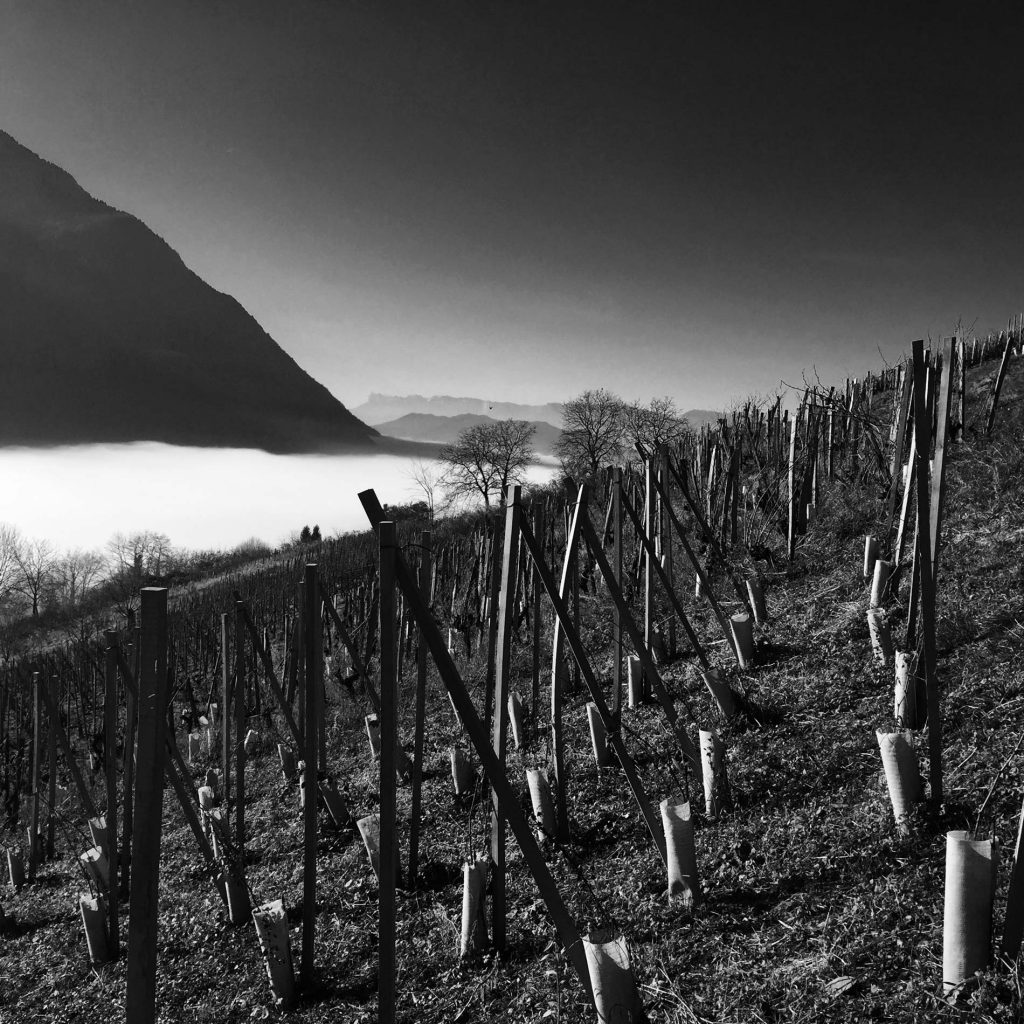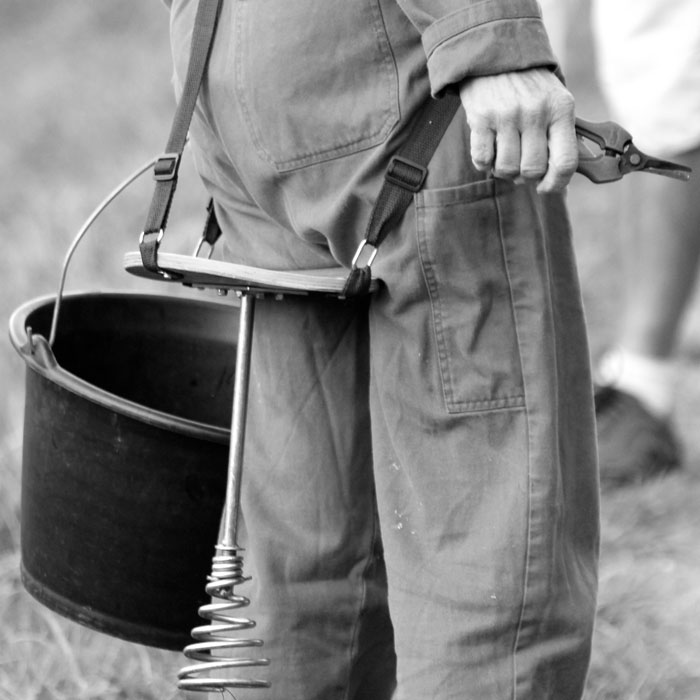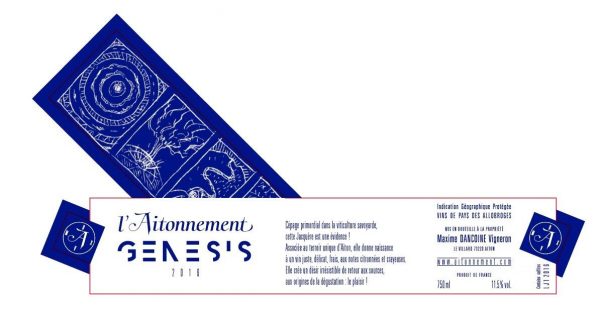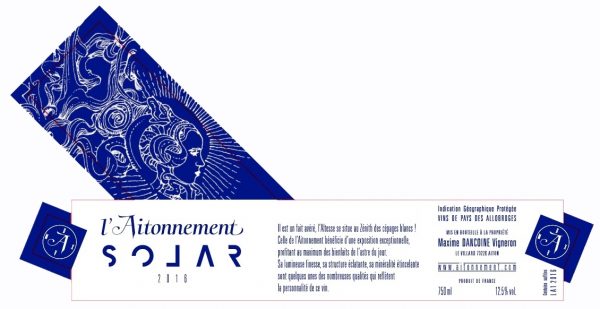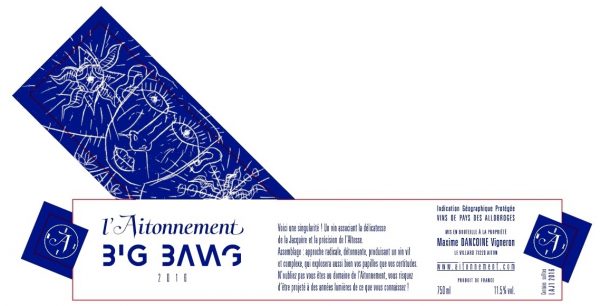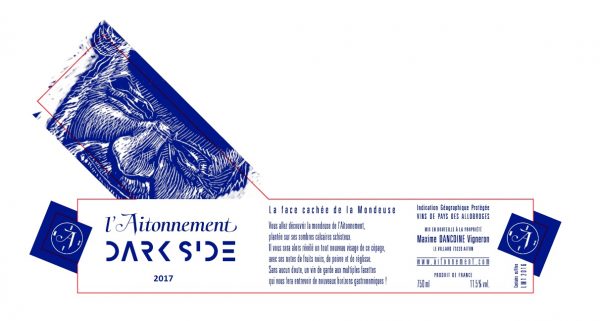L’Aitonnement
The vineyards of the village of Aiton, 30 minutes west of Chambery as one heads towards Albertville and the Alps, were always known for the quality of its Mondeuse and at the end of WWII there were 200 hectares of vines. But there were mentions of the vineyards as long as 300 years earlier. As people moved to larger towns in the 1950s and 1960s, and with the difficulty of working the vineyards (steep hillsides which were impossible for tractors ) the vines were abandoned such that by the turn of the century, there are only a few hectares still cultivated in Aiton. The hillside of Aiton, with its steep slopes and southern exposure, is bathed in sunlight throughout the day. The vines are also influenced by the wind which funneled by the surrounding mountains, flows through the valley and limits problems with rot and mold. The soil is shallow (between 5 and 35cm) according to the slope of the hill (up to 70% slope) and is composed of gray limestone, stones of degraded schist, under which run water from several small springs. Maxime Dancoine took over the domaine of Bernard and Marido Bachellier, the last remaining vignerons in Aiton, in 2016 and produced his first wines. The Bachelliers were already working organically and Maxime added biodynamic practices in the vineyard and cellar Jacquère, Mondeuse Noire, and Altesse are the principal varietals in the vineyards, but they represent only a small part of the varietals that were planted in the Savoie in the past. Since 2016, Maxime has added parcels of Persan and Etraire de la D’hui to his domaine and he has planted Jourbertin Noir, Blanc de Maurienne, Mondeuse Grise and Mondeuse Blanc. The grapes are harvested by hand and vinifications are without SO2, but sulphur is added at filtration (when there is any) or at bottling. Any operations involving the wine are done, as far as possible, according to the lunar calendar – on fruit days with a descending moon. The wine is moved as little as possible and azote or carbon dioxide is used to protect it, thus limiting the use of SO2.
Wines
Jacquere ‘Genesis’
Varietal: Jacquere
Color: White
Farming Practice: Biodynamic
Practicing biodynamic and organic. 100% Jacquere. From 3 parcels in Aiton whose age of the vines is at least 80 years. The slopes here are incredibly steep (up to 70%) and the soil is grey limestone soils mixed with fractured shale on southern slopes at 450 meters. Hand-harvested in late Sept. After slow pressing and the juice is cold settled over 3 days. Native yeast fermentation with some lees stirring at the end of alcoholic fermentation in order for the wine to finish totally dry. Racked down with nitrogen for protection to neutral barrels for ageing. No lees stirring during elevage and malo naturally completes. Racked backed into steel (again with nitrogen) then bottled with only a small addition of sulfur (20 mg SO2). 80 cs produced.
Savoie Altesse ‘Solar’
Varietal: Altesse
Color: White
Farming Practice: Biodynamic
Practicing biodynamic and organic. 100% Altesse. From 2 parcels of head-trained vines in Aiton planted in the late 90s. The slopes here are incredibly steep (up to 70%) and the soil is extremely shallow (only 6 inch deep) grey limestone soils mixed with fractured shale on southern slopes at 450 meters. Hand-harvested in late Sept (he harvests his Altesse earlier than others to preserve a Riesling/Chenin like acidity). After slow pressing and the juice is cold settled over 4 days. Native yeast fermentation with some lees stirring at the end of alcoholic fermentation in order for the wine to finish totally dry. Racked down under a blanked of nitrogen to neutral barrels (228 liters and 400 liter )for ageing. No lees stirring during elevage and malo naturally completes. Racked backed (again under nitrogen) into steel then bottled with only a small addition of sulfur (20 mg SO2). 80 cs produced.
Savoie Jacquere-Altesse ‘Big Bang’
Varietal: Jacquere, Altesse
Color: White
Farming Practice: Biodynamic
Practicing biodynamic and organic. 50% Jacquere, 50% Altesse. From a mix of parcels in Aiton over varying ages (old vine Jacquere and Altesse planted in the late 90s – early 00s). The slopes here are incredibly steep (up to 70%) and the soil is shallow (approx 12 inch) grey limestone soils mixed with fractured shale on southern slopes at 450 meters. Both grapes are hand-harvested in late Sept (he harvests his Altesse earlier than others to preserve a Riesling/Chenin like acidity). After slow pressing and the juice is cold settled over 3 days. Native yeast fermentation with some lees stirring at the end of alcoholic fermentation in order for the wine to finish totally dry. Each grape was fermented separately then blended together in 2016 but were co-fermented in 2017. Racked down under a protective blanked of nitrogen to neutral barrels (228 and 400 liter barrels) for ageing. No lees stirring during elevage and malo naturally completes. Racked backed into steel (under nitrogen again) then bottled with only a small addition of sulfur (20 mg SO2). 115 cs produced.
Savoie Mondeuse ‘Dark Side’
Varietal: Mondeuse
Color: Red
Farming Practice: Biodynamic
Practicing biodynamic and organic. 100% Mondeuse. From 80-year-old vines on a hillside vineyard with with steep slopes (up to 75%) in the area of Puttets which was historically known for the quality of its Mondeuse. The vineyard gets a full southern exposition at an altitude of 450 meters which means the air is cool in spite of the exposition. The soils are the same as the rest of the commune: friable schistic limestone. 2017 vintage went through 15-day semi carbonic maceration until a native fermentation took place at around 25 degrees. The wine was then put into 10-year-old 650 liter barrels for a malolactic fermentation and ageing for 10 months. Bottled with 2 grams of SO2. No fining or filtration. 83 cs produced. Vegan




